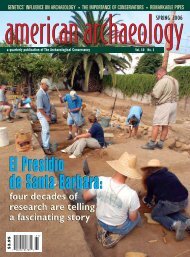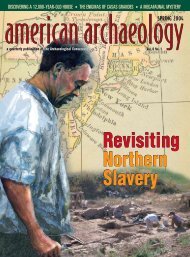Clovis Comet Debate - The Archaeological Conservancy
Clovis Comet Debate - The Archaeological Conservancy
Clovis Comet Debate - The Archaeological Conservancy
Create successful ePaper yourself
Turn your PDF publications into a flip-book with our unique Google optimized e-Paper software.
USSell baily/SiUc UniVerSiTy commUnicaTionS<br />
Paul Welch examines an excavation unit.<br />
various other vermin living in the grass-thatch roof,” said<br />
Welch, noting that historic accounts mention infestations in<br />
the thatch roofs. Since the ash would fall into the trenches at<br />
the base of the walls, the perimeters of the burned buildings<br />
show up particularly well on magnetometry images. “Working<br />
with magnetometry has been the key to our effectiveness,”<br />
Tamira Brennan and Brian Butler (standing) watch as students measure an area prior to excavating it.<br />
said Butler. “It serves as a guide for deciding where to dig.”<br />
In 2003, the Kincaid Mounds Support Organization<br />
wanted to build a small interpretive overlook for visitors.<br />
<strong>The</strong>y consulted the SIUC experts, who commissioned the<br />
first magnetometric survey to guide placement of the overlook.<br />
Since then, approximately 75 acres of the 105 owned<br />
by the state have been surveyed. <strong>The</strong> images have gone a<br />
long way toward satisfying one of SIUC’s research goals,<br />
which is mapping the site.<br />
<strong>The</strong> magnetometry images reveal that the biggest<br />
mounds are arrayed around a plaza. <strong>The</strong>re are indications<br />
of large structures, possibly temples or public buildings, on<br />
some of the mounds—the evidence is large areas that show<br />
high magnetization, consistent with large burned structures—and<br />
dozens of spots throughout the site that most<br />
likely represent houses. <strong>The</strong> houses are arrayed in clusters,<br />
almost like neighborhoods or clan compounds.<br />
One of the earliest revelations was that the Kincaid<br />
community was much larger than originally believed.<br />
“It extended much farther to the west,” Welch said,<br />
pointing to a slight rise well outside what had been<br />
considered the perimeter. <strong>The</strong> Chicago researchers<br />
surmised it was a hillock created by a modern farmer, similar<br />
to two across the road. Welch and Butler suspected it was<br />
a Mississippian mound. To their surprise, the magnetometry<br />
map showed a constellation of 16 houses nearby. A dig<br />
in 2005 confirmed the rise was a mound surrounded by<br />
Mississippian houses.<br />
american archaeology 29




